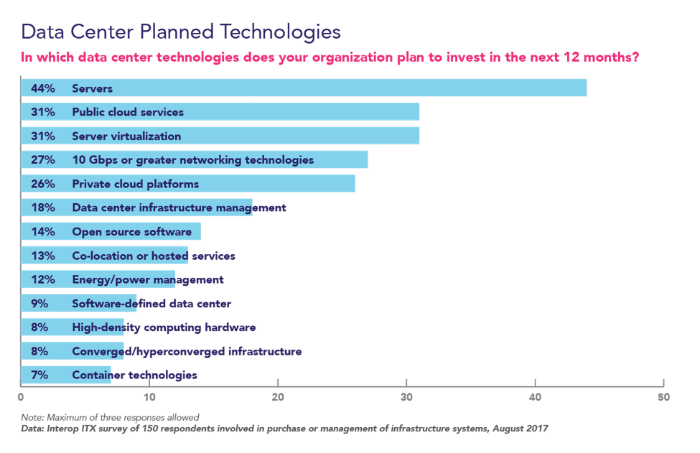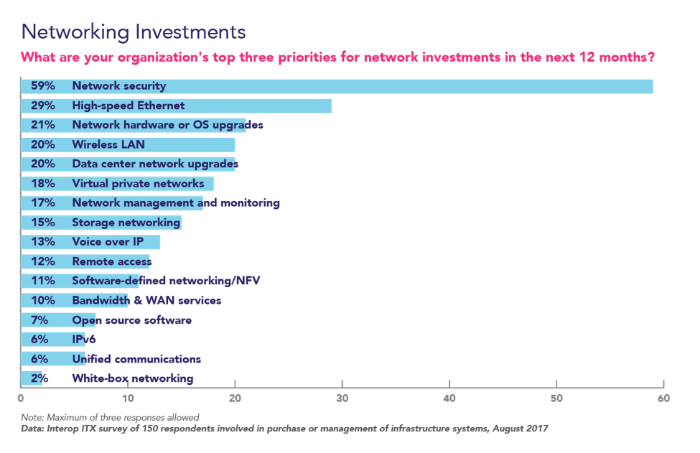IT forecasts for 2018: 8 infrastructure trends

The end of the year is the time for summing up and discussing future trends. We analyzed relevant materials from Gartner analysts, IDG and other companies, in order to understand how the direction of IT infrastructure will actually develop.
1. Geography is an important element of IT strategy.
Gartner Vice President David Capuccio in his article among the main infrastructure trends of the new year calls the transition to geoplanning. This means that more and more companies under the influence of various external factors will not think about building their own global infrastructure that covers the whole world equally well, but about creating a network of IT partners that could provide infrastructure if necessary. For example, when there is a distortion in the geographical distribution of the load.
')
Often, partners can purposefully work on creating an infrastructure suitable for a specific business area - for example, our company provides virtual server rental services for trading on the stock exchange. In such cases, it is even more profitable for business to work according to such a scheme.
2. Data center as a service
According to the Interop ITX study, companies continue to actively invest in the development of their own data centers. More than a third of the companies surveyed stated that they plan to allocate 50% of their IT budget for the next year or even more for this purpose.

At the same time, according to David Capuccio from Gartner, this fact does not prevent the spread of a new approach to work with data centers. It implies a transition from its entire data center to their use as a service (Data center as a service, DCaaS). It does not imply the possession of the object, but the ability to get its resources at the right time, the required volume and the geographical location where it is required and without extra costs.
3. Careful cloud uptake will continue.
For businesses, moving to the cloud is a complex process that cannot be fast. That is why many infrastructure providers provide the opportunity to work with private or shared clouds, which allow companies to better control the process of introducing new technologies.
Services colocation, hosting, as well as various cloud options are combined to meet business challenges, while issues of the physical structure of such infrastructure often fade into the background, says vice president Gartner. Among other things, this leads to the fact that different and even competing approaches to its construction can merge together for business.
This happens, for example, with the concept of Edge computing, which was previously considered as a competitor to traditional clouds. However, according to Gartner analysts, sharing them can be beneficial for businesses - in such an infrastructure, the cloud will be responsible for creating a convenient service, and edge technologies will eliminate the need to have a permanent Internet connection.
4. Optimization of data storage - one of the main tasks
The total amount of data to be stored is constantly growing, so the costs for new data centers and data warehouses will increase. According to Cisco estimates published in 2015, by the end of 2017, the volume stored in data centers will be 370 exhibate, and the total amount of storage will be 600 db. In 2018, this figure can almost double and amount to 1.1 zettabytes.
21% of respondents to the Interop ITX study stated that next year they plan to purchase hardware for organizing data storage - this is a more popular waste than the purchase of network equipment and servers.
Some companies see the prospect of using cloud technologies precisely in solving tasks related to data storage - 37% of respondents noted the use of clouds for storing backups, and another 31% - for archiving.
David Capuccio of Gartner, in turn, claims that in the case of its own architecture and using clouds, the main task for the business in the new year is to take stock of the situation in which IT resources are paid for but not used ( stranded capacity).
5. Safety worries more and more companies.
The outgoing 2017 was marked by increased activity of cybercriminals. The attacks of crypto-worms like WannaCry, the leakage of the CIA’s burglary tools (Vault 7 package) and the hijacking of client data during major hacks, as in the case of Equifax, only confirmed the importance of security investments.
IDG analysts predict an increase in the number of similar incidents in 2018, while corporate clouds will be one of the main targets of hackers. To avoid problems, businesses will have to invest more in security - in particular, they will have to use specialized tools to prevent and investigate cyber attacks (WAF, SIEM, etc.)
It is security that will eventually become one of the main drivers of growth in investments in corporate networks - for almost 60% of companies this is the main task.

6. API revolution continues
Gartner Vice President David Capuccio identifies five areas of support for digital business: information systems, user experience, data and analytics, the Internet of things and ecosystems. To create ecosystems, you need the ability to integrate with third-party systems and products - through an API
Gartner analysts predict a shift from developing an API based on existing infrastructure to designing them based on the requirements for a common technological business ecosystem. Thus, a business does not just open access to those services that it already has, but will be able to increase the level of service by connecting to external resources - this is much more effective than Cappuccio.
7. Preparations for a more massive introduction of AI
Analysts are actively highlighting the possible benefits from the introduction of artificial intelligence technologies to solve business problems - from improving the user experience to making decisions. However, it is not worth waiting for a breakthrough in this area in 2018, while the business is only eyeing new technologies.
So a recent survey of Gartner showed a steady increase in interest in the topic, but so far the vast majority of companies are not moving to active actions - 59% of respondents said that they are only at the stage of collecting information.
8. The blockchain's prospects will become clear.
The blockchain technology became a real hit in the outgoing year - only lazy people did not discuss its possible applications. For example, it looks like a graph of the growth of interest in the topic:

Source: Google Trends
It is believed that this concept will have a revolutionary impact on many industries. However, at present, blockchain technologies differ in their youth with inherent children's diseases, their effectiveness on really large scales has not been proven, and business is confused by legal aspects and lack of regulation, analysts at Gartner note.
During 2018, the prospects of the blockchain will finally become clear. Companies will understand what this technology can give them, what limitations it carries, how costly it will be to implement.
More useful links and materials from King Servers :
- Free infrastructure test from King Servers
- How and why we created a knowledge base
- How to choose a data center for an IT project in Russia: uptime, money and overall adequacy
- Popularity statistics of operating systems in IaaS: Ubuntu is still number one, CentOS popularity is growing
- When the “cloud” breaks down: what can be done in this situation?
Source: https://habr.com/ru/post/345078/
All Articles